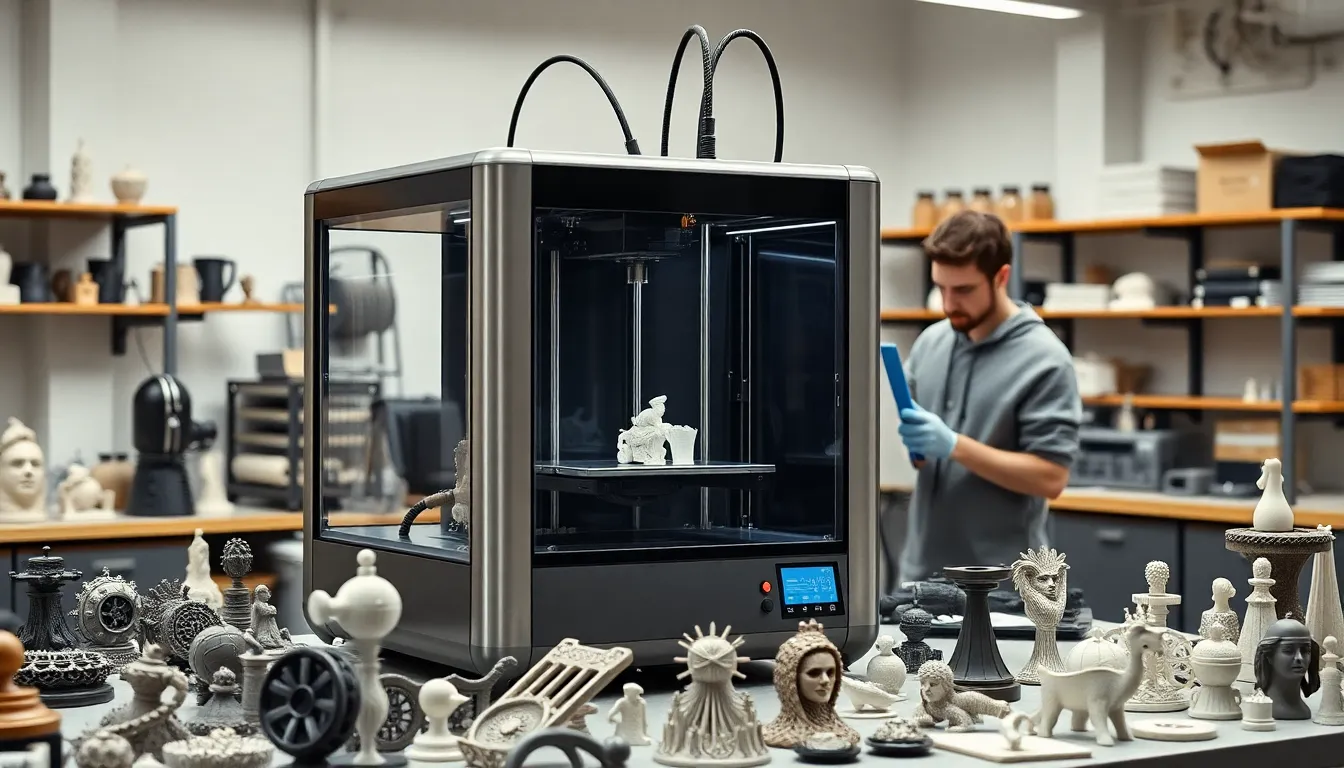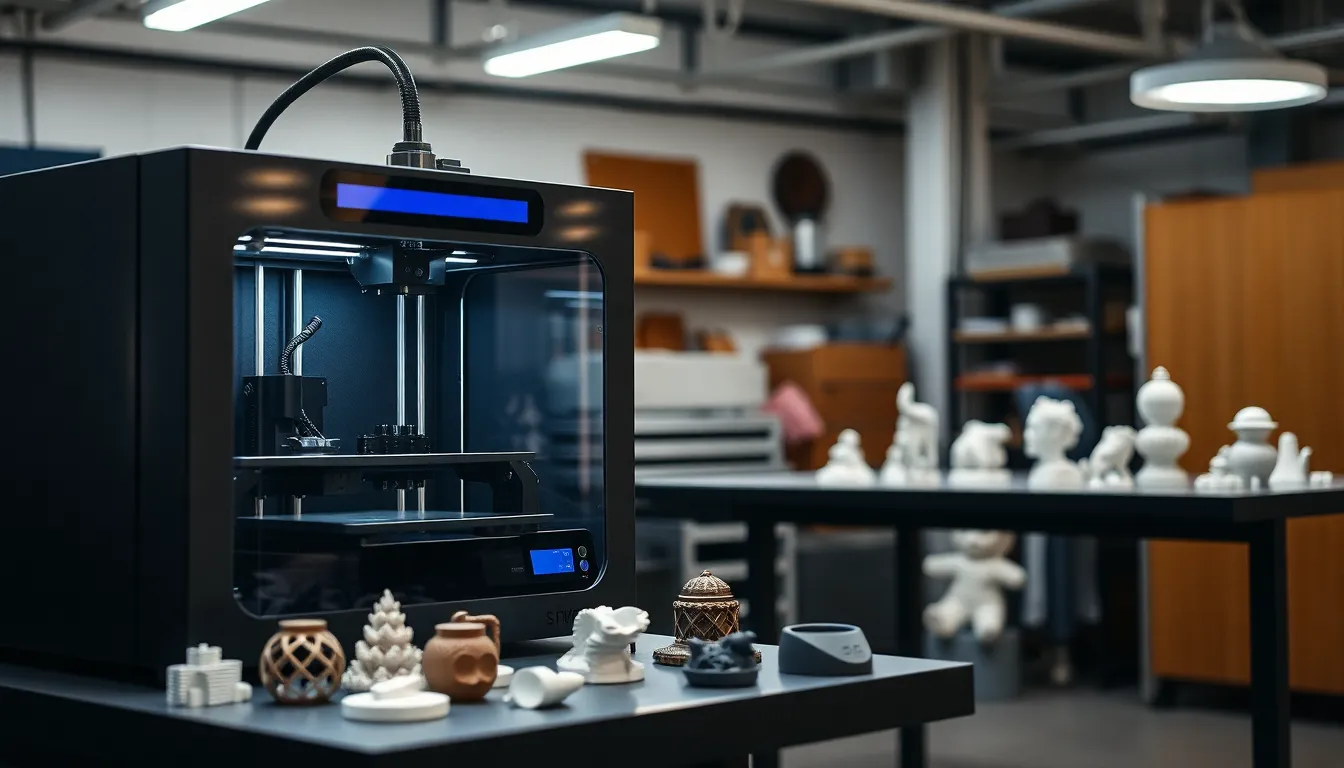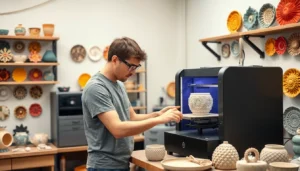Table of Contents
ToggleIn a world where dreams can become tangible in a matter of hours, 3D printing services are the magic wands of modern manufacturing. Gone are the days of waiting weeks for that perfect prototype or custom gadget. With just a few clicks, anyone can transform wild ideas into real-life objects—no fairy godmother required!
Overview of 3D Printing Services
3D printing services revolutionize the way products are manufactured. These services facilitate the quick transition from digital designs to physical objects. In various industries, including automotive, healthcare, and aerospace, companies leverage 3D printing to streamline production processes.
Rapid prototyping stands out as a key feature. Engineers and designers benefit from creating and testing prototypes in days rather than weeks. Custom fabrication allows for unique designs that meet specific client requirements efficiently. Additionally, businesses can reduce waste by utilizing only the required materials during the printing process.
Many service providers offer a range of options. Materials such as plastics, metals, and ceramics are commonly available for diverse applications. Each material contributes distinct advantages, such as durability or flexibility. Clients have the opportunity to choose the best fit for their projects.
Overall, 3D printing services enhance innovation. Startups utilize these services to test concepts without large upfront investments. Established firms integrate 3D printing into their supply chains to improve responsiveness to market demands. Organizations also utilize on-demand printing to minimize storage needs and inventory costs.
The advantages of 3D printing services include rapid production, customization, and material efficiency. Companies increasingly recognize the importance of adopting these technologies in today’s competitive landscape. Investing in 3D printing can lead to significant improvements in design and manufacturing capabilities.
Benefits of 3D Printing Services


3D printing services offer significant advantages across various industries, enhancing production processes and product development. The benefits include cost-effectiveness and time efficiency, which play vital roles in modern manufacturing.
Cost-Effectiveness
Organizations save on production costs with 3D printing services. Custom parts often require less material compared to traditional manufacturing methods. Reduced waste contributes directly to lower expenses. In addition, companies avoid hefty tooling costs and can produce low volumes economically. Short production runs become feasible without incurring prohibitive costs. Startups particularly gain from this flexibility, allowing them to test concepts affordably. Compared to conventional manufacturing, 3D printing enables businesses to allocate resources more effectively.
Time Efficiency
Rapid production is a hallmark of 3D printing services. Designers create prototypes and products in days instead of weeks. As a result, the time from concept to market shrinks significantly. Iterative testing becomes swift, enabling prompt modifications based on feedback. This speed not only accelerates product development but also enhances responsiveness to market trends. Efficient production minimizes downtime and maximizes output. Consequently, manufacturers face less pressure from competitors, fortifying their position in the market. The ability to print on demand further eliminates long lead times associated with traditional inventory management.
Types of 3D Printing Services
Different types of 3D printing services cater to various needs across industries. Each method boasts unique advantages, allowing businesses to select the best option based on their requirements.
FDM Printing
Fused Deposition Modeling, or FDM printing, represents one of the most widely used techniques. The process involves melting thermoplastic filaments layer by layer to create a solid object. Many industries rely on FDM for prototyping and producing functional parts because of its accessibility and low cost. Materials like ABS and PLA often feature in FDM printing, providing flexibility and strength. Designers value this technique for rapid prototyping, enabling quick iterations. FDM’s lower material costs make it ideal for startups and hobbyists exploring ideas without significant financial risk.
SLA Printing
Stereolithography (SLA) printing utilizes a laser to cure liquid resin into solid parts. This method produces highly detailed and intricate designs, making it suitable for applications requiring precision. Industries such as jewelry and dental use SLA printing for creating models, as it offers excellent surface finish. Various resin types exist, allowing customization for different needs, such as flexibility or heat resistance. SLA’s speed becomes particularly beneficial for projects demanding quick turnaround times while maintaining quality. Engineers and designers appreciate this service for the ability to achieve fine features that traditional methods struggle to replicate.
SLS Printing
Selective Laser Sintering (SLS) uses a laser to fuse powdered materials into solid structures. This approach allows for complex geometries that are often impossible with other methods. Many industries, including aerospace and automotive, benefit from SLS’s ability to create strong, functional prototypes and end-use parts from materials such as nylon and metal powders. SLS printing reduces material waste significantly, contributing to cost-effective manufacturing. Its ability to print multiple parts simultaneously enhances production efficiency, appealing to larger-scale projects. Designers and manufacturers rely on SLS for its versatility in material selection and design freedom.
Applications of 3D Printing Services
3D printing services find applications across numerous industries, each exploiting unique benefits and capabilities.
Prototyping
Prototyping serves as a primary application of 3D printing. Designers and engineers produce prototypes within days, accelerating the product development process. This rapid iteration enables quick adjustments based on feedback, fostering creativity and innovation. Companies can test designs thoroughly before committing to full production, reducing risks associated with new products. Testing materials in real-world scenarios ensures functionality and quality, enhancing reliability. In many cases, 3D printing lowers costs related to traditional prototyping methods, making it accessible for startups and established firms alike.
Manufacturing
Manufacturing processes receive significant enhancements from 3D printing services. Organizations utilize additive manufacturing to create complex parts that would be difficult or impossible using traditional methods. This approach allows for on-demand production, decreasing inventory storage costs, as products can be produced as needed. Industries like aerospace and automotive leverage 3D printing to fabricate lightweight components that reduce overall mass. By minimizing material waste alongside production costs, manufacturers optimize both resource use and budget allocations. Overall, the integration of 3D printing into manufacturing leads to streamlined operations and improved efficiencies.
Customization
Customization showcases another vital application of 3D printing. Companies offer tailored solutions, allowing clients to request specific designs and features based on individual needs. This service becomes especially valuable in sectors like healthcare, where personalized medical devices and implants provide essential benefits. Unique customer demands lead to differentiated products that enhance market competitiveness. Additionally, customization minimizes the need for large inventories, as companies produce items only when orders are received. As a result, businesses adapt to changes swiftly, responding to market trends with agility and precision.
Choosing the Right 3D Printing Service
Selecting a suitable 3D printing service involves evaluating various critical components. Understanding the specific needs of a project supports informed decision-making.
Factors to Consider
Material options play a significant role in 3D printing. Different materials, such as plastics, metals, and ceramics, possess unique properties that impact the final product’s performance. Capabilities of the printer also matter. Some printers excel in precision, while others focus on speed. Additionally, turnaround time is essential. Quick production times benefit projects with tight deadlines. Evaluate customer support and responsiveness too, as these elements influence collaboration. Finally, price structures vary; shopping around helps find a service that fits budget constraints.
Comparing Providers
When comparing 3D printing providers, assessing quality is crucial. Look for reviews and case studies showcasing their work’s effectiveness. Price comparisons reveal cost differences, although the cheapest may not always offer the best quality. Service capabilities should be examined as well. Each provider may specialize in different technologies, requiring specific equipment or expertise. Turnaround times differ too, impacting overall project timelines. Evaluate the flexibility of each service in accommodating custom requests. Furthermore, consider geographical location; finding a nearby provider could reduce shipping costs and lead times. Each factor combines to create a comprehensive picture of the best service for specific needs.






